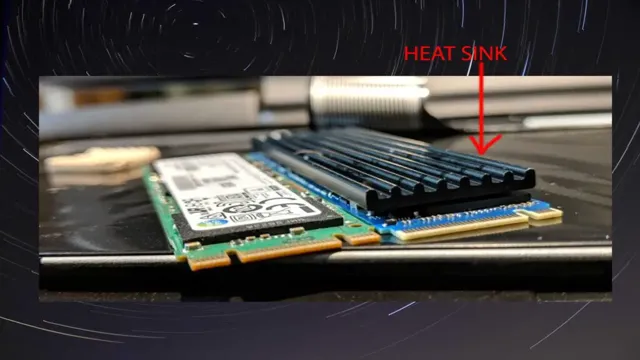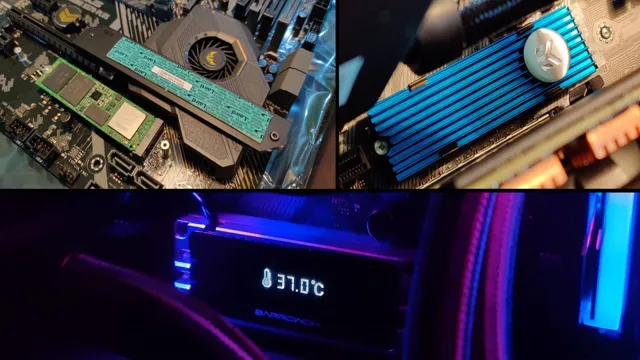If you have ever used or installed an NVMe SSD, you may have wondered whether it needs a heatsink. The answer is not so straightforward. Although NVMe SSDs are designed to operate efficiently without a heatsink, the benefits of cooling an NVMe drive cannot be overlooked.
The passive cooling ability of minimum airflow in typical PC setups may not be enough for optimum NVMe SSD performance. NVMe SSDs are designed to be incredibly fast, but their speed comes at the cost of generating lots of heat. If the heat generated is not dissipated effectively, it can lead to thermal throttling, which can cause the SSD to slow down.
A heatsink can help to lower the temperature of the NVMe SSD by dissipating the heat from the drive to the surrounding air. In this blog post, we will delve into whether or not an NVMe SSD needs a heatsink. We will discuss the pros and cons of using a heatsink, how to install one correctly, and whether an NVMe SSD will benefit from the cooling provided by a heatsink.
So strap in, grab a cup of coffee, and let’s dive into the world of NVMe SSDs and heatsinks.
What is NVMe SSD?
NVMe SSDs are a type of solid-state drive that use the NVMe (Non-Volatile Memory Express) interface to communicate with a computer’s motherboard. These drives are designed to be faster and more efficient than traditional SATA SSDs, and they are becoming increasingly popular in high-performance computing and gaming applications. But, does an NVMe SSD need a heatsink? The answer is not a straightforward one.
While some NVMe SSDs do come with heatsinks built-in, others do not. The need for a heatsink will depend on a few factors, such as the workload the drive will be under and the layout of the computer’s case. In general, if you plan to use your NVMe SSD for demanding tasks such as video editing or gaming, a heatsink might be a good idea.
A heatsink can help dissipate heat from the SSD, which can improve its overall performance and reduce the risk of overheating. However, if your SSD is not going to be under heavy load, or if your computer case has good airflow, you may not need a heatsink. Ultimately, the decision to use a heatsink will depend on your specific needs and the circumstances you are working with.
Definition of NVMe SSD
NVMe SSD stands for Non-Volatile Memory Express Solid State Drive. It is a high-performance storage device that utilizes PCIe interface, and it is designed to provide faster data transfer speeds than traditional hard drives. Compared to other storage devices, NVMe SSDs can read and write data at extremely fast speeds, making it an excellent choice for gamers, content creators, and other high-performance applications.
With speeds of up to 7 GB/s, these drives can significantly improve system performance, reduce lag times, and improve boot times. NVMe SSDs are becoming increasingly popular due to their speed and efficiency, with many PC enthusiasts opting for them as their primary storage device. Overall, if you are looking for a storage device that delivers faster data transfer speeds, then NVMe SSD is the way to go.

How does NVMe SSD work?
One common question people have when it comes to NVMe SSDs is whether or not they need a heatsink. In short, the answer is not necessarily. Unlike traditional hard drives, which can benefit from additional cooling methods, such as a heatsink, NVMe SSDs tend to generate less heat due to their lack of moving parts.
However, if you plan to use your NVMe SSD for heavy data transfers or tasks that require a lot of read/write activity, a heatsink may still be worth considering as it can help dissipate any excess heat that may be generated. Ultimately, whether or not you need a heatsink for your NVMe SSD will depend on how you plan to use it and how much heat it generates.
Explanation of how NVMe SSD works
NVMe SSDs are a game-changer when it comes to storage technology. They work by using non-volatile memory, which means that data is stored on the drive even when the power is turned off. NVMe stands for Non-Volatile Memory Express, which is a protocol that allows the SSD to communicate more efficiently with the computer’s processor.
This makes NVMe SSDs significantly faster than traditional hard drives. The increased speed comes from the parallel channels inside the SSD, which allows for faster data transfer rate. Think of it like a highway with multiple lanes – the more lanes there are, the faster the cars can go.
NVMe SSDs also have much lower latency than traditional hard drives, meaning they can quickly respond to requests for data. Overall, using an NVMe SSD can significantly speed up your computer and improve its performance.
Benefits of using a heatsink for NVMe SSDs
If you’re wondering whether an NVMe SSD needs a heatsink, the answer is typically yes. NVMe SSDs generate a lot of heat during operation, and a heatsink can help dissipate that heat and keep the drive operating optimally. By using a heatsink, you can help prevent thermal throttling, which can slow down the performance of your NVMe SSD.
Additionally, a heatsink can help extend the lifespan of your drive by reducing wear and tear on the components. While not all NVMe SSDs require a heatsink, it’s generally recommended for high-performance drives or when using the drive for intensive tasks like gaming or video editing. If you want to get the most out of your NVMe SSD, investing in a compatible heatsink can help ensure that you’re able to use your drive at its full potential.
Cooling down a hot NVMe SSD
NVMe SSDs, heatsink, cooling down, benefits Have you ever experienced a hot and slow computer thanks to your high-performing NVMe SSD? If so, investing in a heatsink may be the solution for you. By attaching a heatsink onto your NVMe SSD, you can effectively dissipate the heat generated by the drive, preventing any thermal throttling that may occur. But that’s not all – using a heatsink for your NVMe SSD can also increase the longevity of your drive by reducing the wear and tear caused by excess heat.
With improved cooling, your NVMe SSD can maintain its maximum performance level even under heavy loads, allowing your computer to run smoothly without any hiccups. So don’t let a hot NVMe SSD slow down your computing experience – invest in a reliable heatsink and reap the benefits of a cooler, more efficient system.
Preventing CPU overheating
One of the biggest concerns when it comes to computer performance is overheating. Not only can it cause damage to important components, but it can also slow down your system and decrease efficiency. As technology advances, the use of NVMe SSDs has become more common due to their faster speeds and increased storage capacity.
However, these drives also generate a lot of heat and can overheat if not properly cooled. This is where using a heatsink for NVMe SSDs can be beneficial. It helps to dissipate the heat generated by the drive and prevent it from reaching dangerous levels.
The use of a heatsink can also help to improve the lifespan and overall performance of your NVMe SSD by ensuring it stays at a safe temperature. So, if you want to ensure your computer is running at its best, investing in a heatsink for your NVMe SSD is a smart choice.
Does every NVMe SSD need a heatsink?
One of the questions that often arises when building a PC is whether or not an NVMe SSD needs a heatsink. The answer to this question isn’t straightforward, as it ultimately depends on the specific SSD and its intended usage. While some high-performance NVMe SSDs can benefit from a heatsink to help dissipate heat, many mid-range options do not require one.
It’s essential to consider the system’s overall airflow and the SSD’s position on the motherboard when making this decision. If your SSD frequently reaches high temperatures, then adding a heatsink could help prevent thermal throttling and improve performance. Therefore, the answer is not a straightforward yes or no, and it takes careful consideration and assessment to determine whether or not an NVMe SSD requires a heatsink.
Factors to consider when choosing a heatsink
When it comes to NVMe SSDs, the need for a heatsink depends on various factors. Firstly, you need to consider the endurance and reliability of your SSD. If you are a heavy user, constantly pushing your system to its limits, then installing a heatsink is necessary.
This will ensure that the SSD doesn’t overheat, making it more durable and reliable. Additionally, the type of workload you handle on your system is also crucial. For instance, if you are into gaming or video editing, the SSD is likely to generate a lot of heat, which can affect your system’s overall performance.
Therefore, a heatsink is essential in such situations. However, if your workload is not as intensive and you don’t require your system to operate at peak performance, then a heatsink may not be critical. Nonetheless, always consult with your manufacturer’s specifications before making a decision.
When it comes to choosing a heatsink, go for one that’s compatible with your SSD’s form factor, leak-proof, and easily installable. Remember, the choice of a heatsink ultimately depends on your system’s requirements, and installing one can significantly improve your system’s overall performance.
Compatibility with your motherboard
When it comes to NVMe SSDs, one concern that many people have is whether or not they need a heatsink. The answer? It depends. Some NVMe SSDs come with built-in heatsinks, while others do not.
Additionally, compatibility with your motherboard can also play a factor. Some motherboards come with dedicated heatsinks for NVMe SSDs, while others do not. Ultimately, whether or not you need a heatsink for your NVMe SSD depends on a number of factors, including the make and model of the SSD and the motherboard you’re using.
That being said, even if your SSD doesn’t technically require a heatsink, it’s often not a bad idea to install one anyway. This can help ensure that your computer runs optimally and prevent damage to your components from overheating. So, while not every NVMe SSD needs a heatsink, it’s definitely something to consider if you want to get the most out of your system.
Conclusion
In conclusion, the answer to whether or not an NVMe SSD needs a heatsink largely depends on the specific use case and preferences of the user. While some may argue that a heatsink is necessary to maintain optimal performance and extend the lifespan of the SSD, others may find that the added cost and complexity is not worth the marginal benefits. Ultimately, the decision is yours – just remember to keep your PC cool and choose wisely!”
FAQs
What is an NVMe SSD?
An NVMe SSD is a type of solid-state drive that uses a high-speed interface to connect to a computer’s motherboard.
Do all NVMe SSDs need a heatsink?
No, not all NVMe SSDs require a heatsink. However, some models may benefit from the additional cooling.
What are the benefits of using a heatsink with an NVMe SSD?
A heatsink can help to dissipate heat more effectively, which may improve the longevity and performance of the NVMe SSD.
How do I know if my NVMe SSD needs a heatsink?
The best way to determine if your NVMe SSD needs a heatsink is to check the manufacturer’s specifications or consult with a knowledgeable hardware expert.
